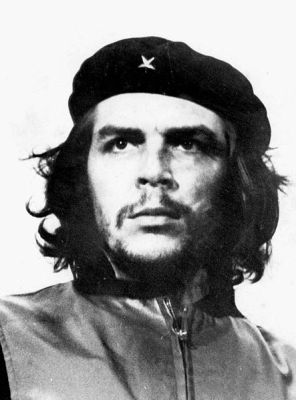Ernesto Guevara was born in l928. When he was two, he moved to Cordoba, Spain, because of asthma. As a young child, Guevara became interested in reading Marx, Engels, and Freud found in his father’s library. As he grew up, he watched the Spanish refugees from the Spanish Civil War fight against the fascist dictator, Francisco Franco. Mr. Guevara was influenced by the war and refugees. He began to hate military politicians, the U.S. dollar, and parliamentary democracy. Ernesto’s parents were both anti Franco activists. In Buenos Aires, Mr. Guevara went to medical school. He graduated in l953. After several years, Ernesto went to Guatemala writing articles on the Inca and Myan ruins.  During his stay in Guatemala, he had the chance to become a government medical personnel. He refused this chance because he did not want to join the Communist party. Therefore, he was penniless for a number of years. Shortly thereafter, Guevara met one of Fidel Castro’s lieutenants with whom he fled to Mexico City. In Mexico City, he also met Fidel Castro, and his brother Raul. In Fidel Castro, he saw a great Marxist leader that he was seeking. Guevara joined Castro followers at a farm where they were training for guerrilla war tactics. The tactics were those first used by Mao Tse-Tung. At this time, Ernesto Guevara first was nick named “Che”, which is Italian for pal. The group invaded Cuba, where Che was commander of the revolutionary army.
During his stay in Guatemala, he had the chance to become a government medical personnel. He refused this chance because he did not want to join the Communist party. Therefore, he was penniless for a number of years. Shortly thereafter, Guevara met one of Fidel Castro’s lieutenants with whom he fled to Mexico City. In Mexico City, he also met Fidel Castro, and his brother Raul. In Fidel Castro, he saw a great Marxist leader that he was seeking. Guevara joined Castro followers at a farm where they were training for guerrilla war tactics. The tactics were those first used by Mao Tse-Tung. At this time, Ernesto Guevara first was nick named “Che”, which is Italian for pal. The group invaded Cuba, where Che was commander of the revolutionary army.
From then on, he was known as the most aggressive, clever and successful guerrilla officer. He also got the reputation for cold- blooded cruelty. One reason for this reputation was because of his orders to mass execute followers of the former Cuban president Batista. Thereafter, Che Guevara was second only to Castro in the government of Cuba. As the years went on, Guevara ran the department of industry for Cuba. The government they formed was communist but very different from the then Russian government. Ernesto attacked the Russian style of Communism and said “It was tacit accomplice of imperialism.” The Russians were not trading only with communists and they were not giving under developed countries aid. After April of l965, Guevara disappeared from the public eye. Castro dropped his association with Guevara because of Che’s criticism. Che’s plan at that time was to bring about Marxism by starting a world-wide revolution. He went around the world with forces (120 Cubans). In Congo, they attempted to accomplish one of these revolutions. It fell short when Belgian aid arrived to help the current government. Che had little help from the rebels of Congo and eventually failed. His final days were spent in Bolivia where he used bad judgment by trying to start a revolution. His troops were crushed, and he was captured by the Bolivian Army.
Che was shot the next day. Ernesto “Che” Guevara is known even today in Vollegrande, Bolivia as a hero to many citizens. He is a symbol of power for the oppressed people. Guevara is thought of by many as a saint. Pictures of Che remain in many windows. To the youth of America in the l960’s and l970’s Che was thought of as an idol. He was viewed as a revolutionary martyr that supported the ideal classless society. In many ways, his thoughts and ideas are important for us today. Now our “democratic” government is only run by rich Caucasian males. The door for the equality in our government has not been open to the rest of society.
